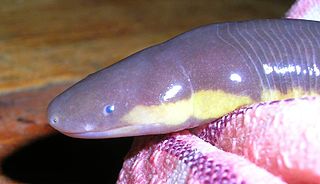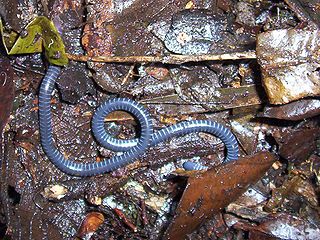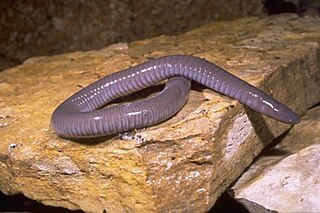
Amphibians are ectothermic, anamniotic, four-limbed vertebrate animals that constitute the class Amphibia. In its broadest sense, it is a paraphyletic group encompassing all tetrapods, excluding the amniotes. All extant (living) amphibians belong to the monophyletic subclass Lissamphibia, with three living orders: Anura (frogs), Urodela (salamanders), and Gymnophiona (caecilians). Evolved to be mostly semiaquatic, amphibians have adapted to inhabit a wide variety of habitats, with most species living in freshwater, wetland or terrestrial ecosystems. Their life cycle typically starts out as aquatic larvae with gills known as tadpoles, but some species have developed behavioural adaptations to bypass this.

Caecilians are a group of limbless, vermiform (worm-shaped) or serpentine (snake-shaped) amphibians with small or sometimes nonexistent eyes. They mostly live hidden in soil or in streambeds, and this cryptic lifestyle renders caecilians among the least familiar amphibians. Modern caecilians live in the tropics of South and Central America, Africa, and southern Asia. Caecilians feed on small subterranean creatures such as earthworms. The body is cylindrical and often darkly coloured, and the skull is bullet-shaped and strongly built. Caecilian heads have several unique adaptations, including fused cranial and jaw bones, a two-part system of jaw muscles, and a chemosensory tentacle in front of the eye. The skin is slimy and bears ringlike markings or grooves and may contain scales.

Ichthyophis is a genus of caecilians found in Southeast Asia, the southern Philippines, and the western Indo-Australian Archipelago.

Caeciliidae is the family of common caecilians. They are found in Central and South America. Like other caecilians, they superficially resemble worms or snakes.

Boulengerula taitana is a species of caecilian. It is endemic to the Taita Hills region of southeast Kenya. Boulengerula taitana are unique caecilians in appearance, fertilization type, and parental care. From their similar shape and presentation to worms, and their internalized fertilization, they set themselves apart from many other amphibians. D. taitana interactions between mothers and newly hatched young is unique in that the mother uses her own skin as a food resource for offspring. This species also has physiological adaptations in place to increase oxygen uptake and affinity to fit their underground lifestyle. The Boulengerula taitana differentiates itself from its close relatives in ways rarely documented and researched before.

Rhinella icterica is a species of toad in the family Bufonidae that is found in northeastern Argentina, southern Brazil, and eastern Paraguay. "Cururu" is its indigenous name and refers to the male advertisement call that is a melodious tremolo. "Cururu toad", without the specifier "yellow", is a common name used for a few other closely related species.

Dermophis mexicanus, also known commonly as the Mexican burrowing caecilian or the Mexican caecilian, and locally as the tapalcua or tepelcua, is a species of limbless amphibian in the family Dermophiidae. The species is native to Mexico and Central America, where it burrows under leaf litter and plant debris.

Microcaecilia is a genus of caecilians in the family Siphonopidae.
Mimosiphonops reinhardti is a species of caecilian in the family Siphonopidae. It is endemic to Brazil. It is only known from the holotype collected from "Brasilia" in 1878, probably somewhere in eastern Brazil. The specific name reinhardti honors Johannes Theodor Reinhardt, Danish zoologist and herpetologist who collected the holotype. Common name Reinhardt's caecilian has been proposed for this species.
Mimosiphonops vermiculatus is a species of caecilian in the family Siphonopidae. It is endemic to Brazil and known with certainty only from its type locality, Teresópolis in the Rio de Janeiro state. Common name worm-patterned caecilian has been proposed for this species.

Schistometopum thomense is a species of amphibian in the family Dermophiidae, endemic to São Tomé and Ilhéu das Rolas. It is found in most soils on São Tomé, from tropical moist lowland forests to coastal coconut plantations. It is absent only from the driest northern areas of the island. It is typically around 30 cm (12 in) in length, and is often bright yellow. The size of S. thomense can vary throughout São Tomé, however, and it is the only known caecilian to follow Bergmann's rule, which states that a decreasing temperature due to factors such as increasing altitude will cause an increase in the body size of endothermic vertebrate species. The island of São Tomé is a massive shield volcano, and it therefore has differing altitudes throughout the island, potentially resulting in the size diversity of S. thomense. This species may be referred to as the São Tomé caecilian, as the Agua Ize caecilian, or as the island caecilian, or by the local name of cobra bobo.
Siphonops leucoderus, the Salvador caecilian, is a species of caecilian in the family Siphonopidae. It is endemic to eastern Brazil and only known from its type locality, the Bahia state. It is assumed to be a subterranean species, possibly living in lowland moist forest.

Siphonops paulensis, or Boettger's caecilian, is a species of caecilian in the family Siphonopidae. It is found in northern Argentina, Paraguay, eastern Bolivia, and southern Brazil. It lives subterraneously in forests, savannas, shrublands, and grassland. It also adapts to anthropogenic disturbance and can even live in urban gardens. In fact these caecilians have even been recorded to breed and raise their young close to Santa Cruz, a highly populated city. It is a locally common species that is not facing major threats.

Corythomantis greeningi, occasionally called Greening's frog, is a venomous frog species in the family Hylidae endemic to eastern Brazil, where it lives in Caatinga habitat. It is usually situated on vegetation, including in bromeliads, and on rock outcrops. Breeding occurs in temporary streams. Although suffering from habitat loss, it is not considered threatened by the IUCN. The specific name greeningi was in honour of Linnaeus Greening (1855–1927), an English businessman and naturalist known for his work on arachnids, reptiles and amphibians.

Ichthyophis glutinosus, the Ceylon caecilian or common yellow-banded caecilian, is a species of caecilian in the family Ichthyophiidae endemic to Sri Lanka. Its natural habitats are moist tropical and subtropical forests and pastures.

The Koh Tao Island caecilian is a species of amphibian in the family Ichthyophiidae found in Cambodia, Laos, Myanmar, Thailand, and Vietnam. Also known as the Ichthyophis bannanicus, the Banna caecilian, it is also found in southern China.

The Siphonopidae are the family of common caecilians. They are found in Central and South America. Like other caecilians, they superficially resemble worms or snakes.

Matriphagy is the consumption of the mother by her offspring. The behavior generally takes place within the first few weeks of life and has been documented in some species of insects, nematode worms, pseudoscorpions, and other arachnids as well as in caecilian amphibians.
Dermophis donaldtrumpi is a name proposed for a putative new species of caecilian – a nearly-blind, serpentine amphibian – to be named after Donald Trump. It was originally discovered in Panama and though the name was proposed in 2018, it has yet to be confirmed as a new species; as of 2024, the binomial name and description of the species has not been formally published. It was given its name after the Rainforest Trust held an auction for the naming rights. The company EnviroBuild won the auction and proposed naming the species in protest against Trump's environmental policies and views.
Dermatotrophy is a rare reproductive behaviour in which the young feed on the skin of its parents. It has been scientifically observed in several species of caecilian, including Boulengerula taitana, and is claimed to exist in the newly discovered unpublished species Dermophis donaldtrumpi.
















